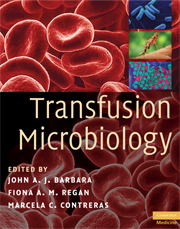Foreword
Published online by Cambridge University Press: 12 January 2010
Summary
Microbiology has been intertwined with transfusion medicine from the outset. It was not long after the development of transfusion as we know it, that viral hepatitis was recognized as an inevitable and largely intractable complication of transfusion. More than fifty years later, we are almost in control of this, and other transfusion-transmissible viruses, but we are, in common with others, facing the unexpected problems of emerging infections. Human immunodeficiency virus, the first of these, was, and still is, an enormous human tragedy. As such, it taught us that blood safety must be managed by action, not words. Further unpredictable challenges have appeared and will continue to beset us. In 1950, who could have dreamed that artificial changes in the way that cattle are fed would result in a crisis in the perception of transfusion safety? Even in 2001, we did not predict the impact of West Nile virus on blood safety – in part because experience had told us that acute infections were rarely transmitted by transfusion.
John Barbara, one of the editors of this book, coined the term ‘transfusion microbiology’, which turns out to be a discipline much greater than the sum of its parts. Managing the risk of transfusion-transmitted infection involves knowledge of a wide range of pathogens, of their pathology and epidemiology, and of the strange interface between human infection, risk behaviour, truthfulness and motivation.
- Type
- Chapter
- Information
- Transfusion Microbiology , pp. xiii - xivPublisher: Cambridge University PressPrint publication year: 2008



